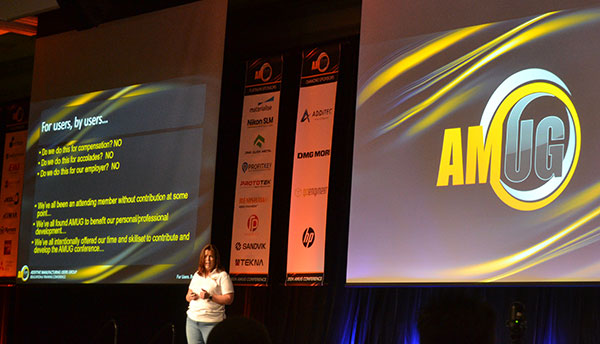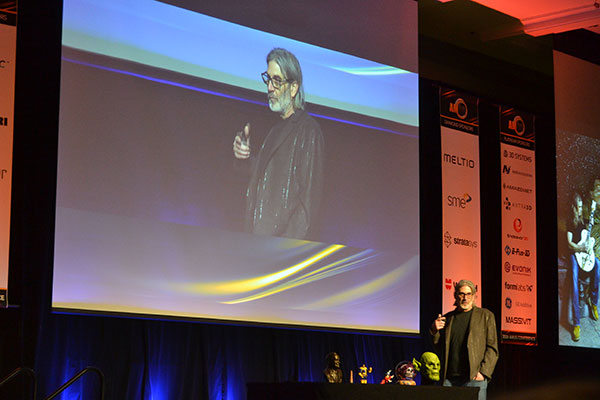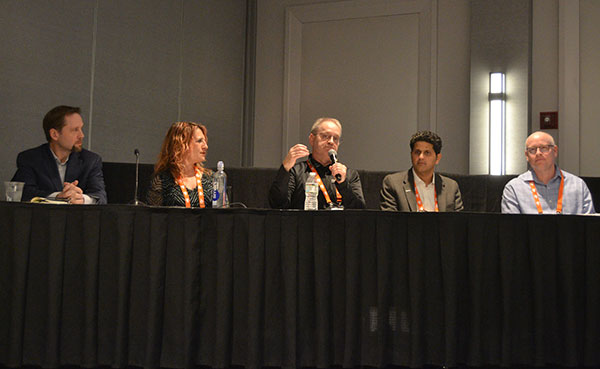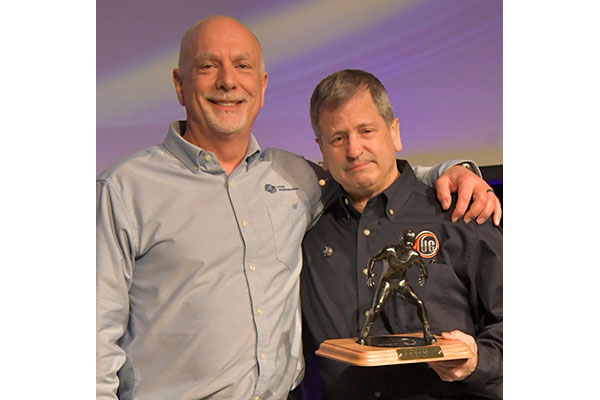Creative Additive Innovators Connect at AMUG Event
This year's user group event, dedicated to advanced technology in the additive manufacturing space, offered ample opportunity to learn and network.

President Shannon Van Deren highlighted features of this year’s event.
Latest News
March 22, 2024
An emphasis on problem-solving mixed with practicality once again aptly tied together the additive manufacturing content at this year’s AMUG conference, March 10-14 at the Hilton Chicago.
“It’s about making it better and making it work—using additive manufacturing to tackle known and unknown challenges,” says Todd Grimm, conference emcee and industry consultant.
“It isn’t different from any other year. That’s why people come to AMUG,” with a simple goal of ‘help me,’” he notes.
Roughly 1,500 additive manufacturing users across the industry spectrum—in the arenas of automotive, aerospace, medical, robotics, defense, academia and more—met up on Michigan Avenue for collaborative discussions, knowledge gathering, product exhibits, and fine dining.
That said, the current economic state may have partially influenced total number of attendees, which saw a slight decrease this year over last year, according to Grimm, who didn’t mince words: “It was a very, very rough year, based on the economics.”
But those who attended live were fully engaged.
At the opening session, Shannon Van Deren and Grimm highlighted features of this year’s event — technology advancements, people transitions, customized applications for additive, a promising manufacturing landscape, the need for workforce development, and more.
The opening session brought the return of visionary creative Jason Lopes, who has built the latter part of his career bringing blockbuster animation to new life with use of additive manufacturing. Some of his credits that use AM include Thor, Iron Man, Avatar and Terminator. His inventive and collaborative work at Hollywood-based Gentle Giant Studios incorporates use of 3D printing technologies, 3D scanning, design, and modeling. Gentle Giant Studios is now working with metal printing, with its first metal 3D print being the glove for the movie Thor.

At the studio, he explains, “we [enjoy] mixing methods and getting beautiful output results. We are breathing life into the workflow,” he said of the workflow at Gentle Giant Studios, that begins with xrite, Lightroom, Reality Capture and Maya to materials, 3D printing and the finished product. During his talk, he spoke on inputs, such as color calibration and the studio’s work on creating color palettes for TV and film properties. He highlighted photogrammetry – “This lane is where it’s at. It’s a completely different lane of color.”
A second keynote later in the week, Olaf Diegel, professor of AM at the University of Auckland in New Zealand and an author of The Wohlers Report, addressed the value of design for additive manufacturing.
“We bookended quite well with inputs from Jason Lopes to the midstream with design for additive with Olaf all the way out to outputs,” Grimm says.
Throughout the week, plenty of tracks left attendees with many options. A well-attended breakout panel session homed in on workforce development. Participants were: Steve Grundahl, Prototek; Evan Kirby, Materialise; Philip Rufe, Eastern Michigan University; Rajeev Kulkarni, formerly with 3D Systems and now with Axtra3D; and Mara Hitner, MatterHackers. It was moderated by Jeannine Kunz of SME.

Kunz kicked it off by asking how to attract and develop the workforce?
“What’s key is that it’s a never-ending process,” says Grundahl. “You don’t just recruit in May before graduation and you’re set. For us it’s a year-round thing. We are working with everything from Boy Scout and Girl Scout troops to doing full-on internships and co-ops with college engineering students. Internally we’ve [also] built a program where someone’s on top of what’s next—where the career fairs are— and really focusing on it.”
Something unique Prototek does, according to Grundahl, is having himself and another staff person participate on an advisory board for technical colleges with prototyping and mechanical design programs.
“We place our staff on those advisory boards so that they’re integrated in developing the curriculum and we can get to know the instructors and the students, forming those relationships. So when it’s time for the career fairs, we maybe have a little bit of an inside track on what students would be a good fit for us. Then we work to bring those students to our facility. Sometimes we pay for the trip—pay for buses, lunch. At the end of the day it’s for recruiting and spreads out costs over the entire year,” Grundahl explains.
Kulkarni, who recently joined Axtra3D, adds, with regard to recruiting efforts, “Sitting on the advisory boards of colleges and universities in your local cities is the number one way to get really good candidates. Within our organization (3D Systems), we were fortunate enough to have many different engineering and marketing programs. This [offers] new opportunities and then the [recruits] can pick the path within the company. There are also financial and education incentives that we provide.”
Hitner of MatterHackers said that for their recruiting efforts, they put together a system so they can hire remote, especially for sales and customer support teams…”We like to keep our culture – super nerds, all the day, all the time, internal and with our customers.”
Hitner also recommended SkillBridge, a government program for transitioning service members, where government teams up with a small business so the business gets an intern for 3 months for free. It’s about “exchanging, teaching, helping to bridge the veterans back into civilian life— for a transitioning workforce that is retiring.”
Other panel discussions highlighted the business relevance of contract manufacturing, the future of AM in the military, a workshop on digital workflow for patient specific devices, manufacturing execution system software for additive, and numerous other tracks in various categories of AM (education/training, metal casting, nonmetal technologies, software, aerospace and transportation, and others.
In another packed panel session, applications of metal 3D printing for tooling was the topic. Addressing what the additive industry really needs, Ted Sorom of Mantle, says, “Manufacturing is an industry of risk reduction. It does not move fast. It keeps going slow. There is huge growth in additive, if you can deliver same parts traditionally at low cost and faster. The problem today is that it’s expensive and slow and doesn't scale. It’s extremely expensive to produce these tools. We are focusing on delivering cost and time reduction.”
As Scott Kramer of Xact Metal sees it, “The more people understand what is available (in metal additive), the faster people will adopt. It's coming. Another tool in your toolbox and [you’re] on your way to get something done.”
Desktop Metal’s Jonah Myerberg adds, “It all comes down to design for additive manufacturing. It starts with understanding design constraints and then starting your design. When it comes to specific processes, such as binder jetting, you’re going to have a different surface finish than when you machine the part.”
On display in the three exhibit halls were dozens of companies offering services, software, hardware, and digitized solutions. Though AMUG does not bill itself as a “launch event,” Grimm says there’s always room for soft launches at the show. “We’re a place for a soft launch when you want to get feedback from an intelligent informed community,” he says. “We don’t expect exciting news. We expect incremental developments that a user will appreciate—a software interface or AI tool, for example.”
Some brief “soft-launch” examples at this year’s event included:
Authentise Tool Blends Generative AI, 3D Annotation
Stratasys Launches New GrabCAD Packages for Additive Manufacturing
Würth Additive Digital Inventory Platform Went Live at AMUG
Meltio Printer Now available for Aluminum and Copper Alloys
HP Releases New Material Developed with Arkema
Materialise Shows Data and Build Prep Software
Velo3D Shares Flow Developer for its Software
Various awards were given during the event, including the DINO awards to honor innovators in the industry, scholarship awards, technical competition awards, and lifetime achievement.

Unexpectedly, Gary Rabinovitz, 3D printing lab manager at Reebok, was named this year’s recipient of the Lifetime Achievement Award. Paul Bates, of ASTM, presented the award.
“I have received other awards in my professional career but none as meaningful as this Lifetime Achievement Award. To be recognized for this award is the culmination of a career that spanned nearly 27 years. I would be locked away in my AM lab printing out parts that make a difference for the way Reebok does business,” he says.
He continues: “In the beginning none of us really knew what we were doing with AM or what the capabilities really were. That was the major importance of AMUG and our user community. We could openly share tips and trick to help each other through the tough builds, no matter if we were in the same industry or not. This was a major reason why I became a volunteer way back in 1998 and have not stopped since,” he says, acknowledging Paul Bates, his first Reebok manager and who he views as his best friend for “raising my hand for me when the call for a vice president was announced.”
New to this year’s event was the AMUGderby, built on the likes of the Pinewood Derby, attracting 87 entries. Speed winner was Steve Charles of MacLean Additive, top finisher in all 12 races he competed in. Design award goes to Lino Stavole of Ricoh 3D Healthcare for an alien theme.
For the technical competition the following were winners:
Advanced Concepts: Chris Baschuk of Point Designs for a shoulder displacement entry;
Advanced Finishing: Mike Littrel of BuildParts powered by CIDEAS for coin-operated rides
Members Choice: Sam Mills of Eaton for a lighting luminaire.
For the future direction of AMUG, Grimm says the organization plans on “keeping the course. Our model, what we do and the information we provide, has worked over the years. If anything, we will expand or look at new niches.”
Looking ahead, in 2026 (March 15-19), users may want to mark their calendars for a new locale – Reno, NV. (The 2025 event, slated for March 30 to April 3, will remain in Chicago.)
As for the future of additive, Grimm’s personal take is he expects to “continue to see shakeout in the industry. I think that’s a very good thing, because we’ve got too many players. Our industry I believe was artificially sized by number of competitors based on free-flowing capital that was available and whether the company deserved to be in the industry or not. They could tell a good story. The shakeout will weed out the weaker players, which I think we need. Going back to the practicality, [there are] even more justifiable reasons for the 3D printing applications. There’s true need and 3D printers can fill it.”
Subscribe to our FREE magazine, FREE email newsletters or both!
Latest News
About the Author
Stephanie is the Associate Editor of Digital Engineering.
Follow DERelated Topics






